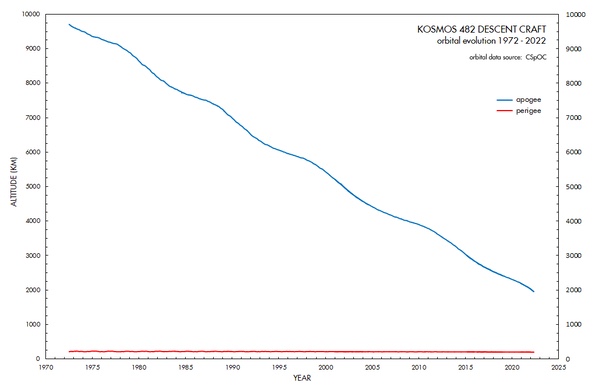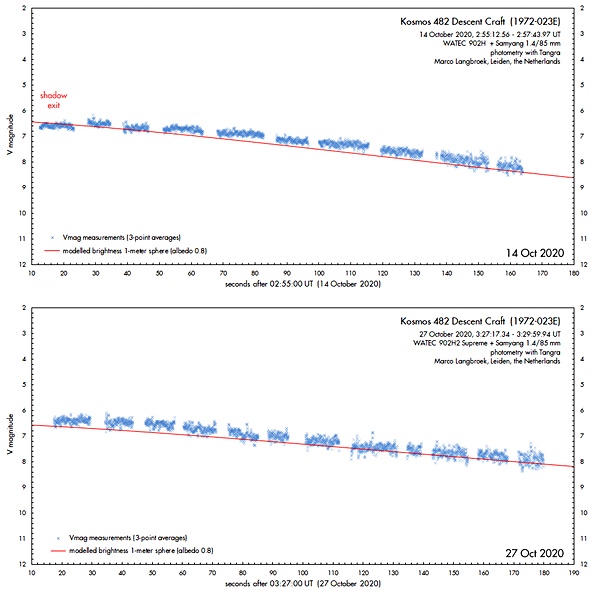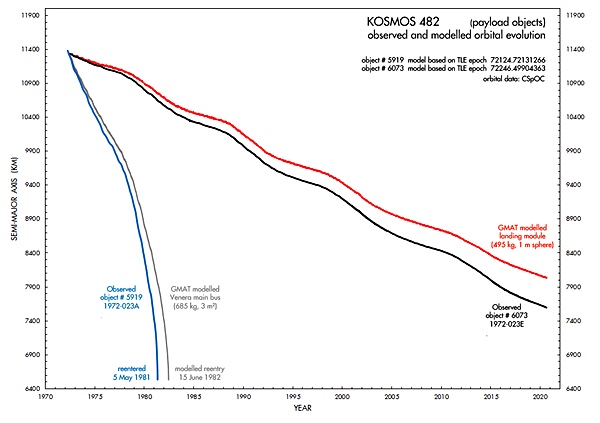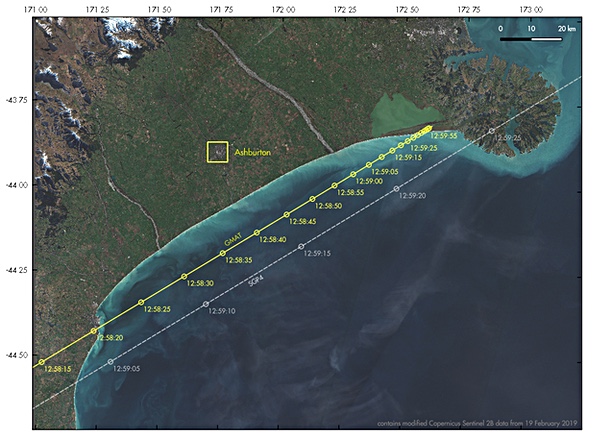
Kosmos 482: questions around a failed Venera lander from 1972 still orbiting Earth (but not for long)by Marco Langbroek
|
| Half a century later, one object associated to this launch is still on orbit, but it won’t be for long anymore. |
The identity and real size of this object have recently been put to discussion, with some arguing it is not just the lander but includes a substantially larger part of the original Venera bus. I will present evidence, both observational and modelled, that this object is in fact the landing module only, not a substantially larger part of Venera hardware. I model it to reenter some three to four years from now, around 2025–2026. Being designed to pass through the atmosphere of Venus, it will likely survive its reentry into the Earth’s atmosphere.
Kosmos 482 launched from Baikonur only four days after the Venus probe Venera 8 was launched, and was likely of the same design. Unlike its successful sister ship, Kosmos 482 got stuck in a 206 x 9802 kilometer, 52-degree inclined highly elliptical orbit around the Earth. The upper stage of the Molniya 8K78M that should have propelled it into a heliocentric orbit to Venus shut down prematurely, apparently because of a wrongly set timer.
Initially, western military space tracking networks catalogued four objects connected to this launch. In addition to the Venera payload itself, these objects ostensibly were the Molniya Block L upper stage in a 206 x 9770 kilometer, 52-degree highly elliptical orbit; the Molniya second stage in a 206 x 326 kilometer, 51-degree low Earth orbit; and the Ullage platform in a 206 x 223 kilometer, 51.7-degree inclined low Earth orbit.
| NORAD | COSPAR | DESIGNATION | REENTRY | INITIAL ORBIT |
|---|---|---|---|---|
| 6073 | 1972-023E | COSMOS 482 DESCENT CRAFT | 2025 - 2026 a | 210 x 9710 km |
| 5919 | 1972-023A | COSMOS 482 b | 05-05-1981 | 206 x 9802 km |
| 5923 | 1972-023D | SL-6 r/b (2) c | 20-02-1983 | 206 x 9770 km |
| 5920 | 1972-023B | SL-6 r/b (1) d | 01-04-1972 | 206 x 326 km |
| 5921 | 1972-023C | SL-6 PLAT e | 02-04-1972 | 206 x 223 km |
a: prognosis based on GMAT modelling by author
b: Venera main bus
c: upper (3rd) stage NVL Block L
d: 2nd stage Block I
e: Ullage platform
Sometime after the launch, the payload (1972-023A) separated into two objects. One of these kept the designation 1972-023A and was believed to be the Venera main bus. The second one got the designation 1972-023E (catalogue no. 6073) and is believed to be the Descent Craft, i.e. the actual landing module meant to be landed on Venus.
My analysis of the orbital elements of these two objects suggests that the separation happened in mid-June 1972, some 80–85 days after the launch. There is some evidence of a small discontinuity in the semi-major axis evolution of the 1972-023A object around June 21 of 1972, and a conjunction analysis suggests that the two objects were close near that same date. The separation was not necessarily the result of an explosion or otherwise violent breakup. After all, the main bus and descent craft are meant to separate at some point. From the difference in orbital altitude between both objects, I calculate the delta V involved in the separation to be around 8.5 meters per second. I have not been able to find information on the typical delta V with which a Venera lander is ejected from the main bus.
The ostensible main bus, 1972-023A, reentered on May 5, 1981, nine years after launch. The other object, the descent craft, 1972-023E, is the only object from this launch still in orbit today, and the main object of this study.
When the “Descent Craft” was first catalogued in July 1972, it was in a 210 x 9710 kilometer, 52.1 degree inclined orbit. Over the past 50 years the apogee altitude of this object has come down by more than 7,700 kilometers, and as of May 1, 2022, the object is in a 198 x 1957 kilometer orbit.
The image below shows the difference between the mid-1972 and mid-2022 orbits. The diagram shows the evolution of the apogee and perigee altitudes over 1972–2022.
 Venera 8 orbit of 1972 versus its orbit of 2022. |
 Evolution of the orbit over the period 1972–2022. |
Whether the Kosmos 482 “descent craft” is truly only the descend craft, i.e. the lander module contained in its approximately one-meter-diameter protective semi-spherical cover (see the image at the top of the article), has recently become a point of contention. In early 2019, a news item appeared on Space.com titled “Failed 1970s Venus Probe Could Crash to Earth This Year”. It was subsequently picked up by a number of news outlets, such as Newsweek and NBC News.
In these news items, two claims were made, both as it turns out unsubstantiated:
(1) that the object could reenter as early as that same year (2019);
(2) that the object is not just the lander module, but that it includes a substantial part of the Venera bus.
| The claim of “strong brightness variations” is something that is not borne out by my own observations on this object. |
Regarding the first claim about an “imminent” reentry of this object, both Jonathan McDowell in a solicited comment in the Space.com article, and myself in a solicited comment for Universe Today, pointed out that the orbital decay history of object 1972-023E was inconsistent with a reentry later that year and instead pointed to a reentry still several years in the future.
The two arguments given for the second claim, the claim that the object is not just the lander but includes a (considerable) part of the Venera bus, are:
(a) a reportedly “strong brightness variation” of the object;
(b) apparent detail and an “elongated shape” as seen on telescopic images of the object made by Dutch astrophotographer Ralf Vandebergh.
The claim of “strong brightness variations” is something that is not borne out by my own observations on this object. I have filmed it several times and never noticed a strong brightness variation. On the contrary, it is very stable in brightness.
Kosmos 482 Descent Craft, 27 Oct 2020 from Marco Langbroek on Vimeo.
As an example, the diagrams below show photometric observations of 1972-023A obtained on two nights in October 2020. In both cases data acquisition started just after shadow exit. The object was filmed with a WATEC 902H camera fitted with a 1.4/85 mm lens at 25 frames/second, and each dot is the average of photometric measurements on three frames. The gaps in the curves are moments that the camera was repositioned. As the WATEC is red-sensitive with a different response than the human eye, a simplified correction from red to visual magnitudes was employed. This was done by measuring reference stars, then plotting the measured values against catalogue visual magnitudes for these stars, and fitting a curve to the datapoints, yielding an equation that relates R magnitudes to V magnitudes.
 Photometric brightness curves for 1972-023E. |
These brightness curves show no sign of strong brightness variations: in fact, the object is very steady in brightness. The gradual decrease in brightness over the curves is in line with the changing phase angle of the object and range to the camera, as it is closely following theoretical expectations. The red line in the diagrams is the theoretical brightness of a one-meter-diameter sphere (assuming an albedo of 0.8, for white paint) at the relevant range and phase angles. It is very close to the observed values. If this object shows occasional sudden brightness variations, then these are clearly not very common or typical for this object.
The idea that 1972-023E might be more than just the one-meter landing capsule got hold because of telescopic imagery by Dutch astrophotographer Ralf Vandebergh. It purports to show detail of the shape of the object. Based on this imagery, the Russian Space Web website suggested that the landing module is still attached to the Venera main bus. This idea is echoed in comments by Thomas Dorman (“our guess is maybe as much as 40 to 50 percent of the upper spacecraft bus may still be there”) in the 2019 Space.com article with the erroneous reentry prediction. The mistaken notion that a significant part of the Venera bus (or even the complete bus) would still be present, was probably the root cause of the failed prediction.
The telescopic imagery in question can be seen on Vandenbergh’s website, while a different set of Vandenbergh’s images is on the Russian Space Web website, where they are compared to pre-launch images of a Venera spacecraft in assembly.
| The RCS data are in line with an object the size of the landing module rather than a much larger object. |
I am, however, skeptical with regard to the detail in Vandenbergh’s telescopic imagery. Unlike amateur imaging of the ISS, this is imaging at the edge of telescopic resolution. Even when imaged right overhead and in perigee, at a range of 200 kilometers, a Venera main bus would not measure more than 3 arcseconds, while the landing probe would be a mere one arcsecond. Atmospheric turbulence (certainly at sea level) has a large influence at this very small scale. In planetary imaging, reliable detail at this small scale can generally only be obtained by stacking large numbers of frames, not from single frames.
Vandenbergh’s imagery is not obtained by means of stabilized motorized tracking but rather with a fully hand-tracked telescope. This introduces a very unstable image, and by Vandenbergh’s own admission “the efficiency of usable frames with this tracking technique is minimal”. In practice, it means that only a few frames that are judged to have minimal distortion by telescope shake and atmospheric turbulence are selected by means of a cherry-picking process. This is a very biased procedure. Combined with the very limited resolution, there is no reliable, objective way to tell what “details” are in reality due to camera shake and/or turbulence, and what “detail” is real.
Data on the radar cross section (RCS) also argue against the notion that 1972-023E is a complete Venera bus rather than just the landing module. RCS data are available for both 1972-023A (the Venera main bus) and 1972-023E (the “descent craft”). The CSpOC catalogue lists a “large” RCS for 1972-023A, the presumed Venera bus, with “large” being an RCS > 1.0 square meters. For 1972-023E it lists a “medium” RCS, with “medium” being an RCS between 0.1 and 1.0 square meters. Archived data from the time that CSpOC still published actual RCS values, kindly made available by Mike McCants, give a median RCS value of 0.72 square meters for 1972-023E (for 1972-023A no such archived data are available). The commercial tracking company LeoLabs lists an RCS value of 1.3 square meters for 1972-023E, almost double the CSpOC value.
These values correspond to an object with a diameter of approximately 0.96 meters (CSpOC) to 1.29 meters (LeoLabs), although we should take into account that a radar cross section is not necessarily the same as the true metric cross section. Nevertheless, the RCS data are in line with an object the size of the landing module rather than a much larger object.
Further arguments that 1972-023E cannot be the full Venera bus, or the lander with a substantial part of the Venera bus still attached, come from the orbital evolution of 1972-023A and 1972-023E.
The expected orbital evolution for these objects was assessed with the General Mission Analysis Tool (GMAT) 2020, an open source NASA tool. Starting points of the simulations were mid-1972 orbits for both objects, sourced from Space-Track. The 1972-023A simulation was done for a three-square-meter cross-section object with a mass of 685 kilograms (for the main bus minus the lander). The 1972-023E simulation was done for a 0.785-square-meter cross-section object (a one-meter sphere) with a mass of 495 kilograms. Historical space weather data and the MSISE90 model atmosphere were used in the simulations.
The results of these GMAT simulations can be compared to the observed orbital evolution of these two objects. The diagram below shows CSpOC data on the observed orbital evolution compared to the GMAT simulation results.
 Observed orbital evolution versus modelled orbital evolution. |
It should be noted that we cannot expect the simulations to exactly match the real orbital evolution. They are after all only models (the proverbial caveat about “spherical cows in a vacuum” applies). Experience with reentry modelling has shown that the uncertainties in simulated reentry time are typically some 20% of the length of the simulation period. This means that for a ten-year simulation length ending with reentry, we can expect an uncertainty of two years in the modelled reentry date.
Bearing this in mind, there is a good satisfactory match between the simulated orbital evolution for both objects and the observed orbital evolution. For 1972-023A, the presumed Venera main bus that reentered in May 1981, nine years after the start of the simulation, the modelled reentry date is about one year after the real reentry date. And the evolution of the 1972-023E orbit, the presumed descent craft, also follows the orbital evolution modelled for such an object size and mass well.
As a note: looking at the data, GMAT seems to slightly underestimate the speed of orbital decay for both objects (a point to keep in mind for when we discuss the probable future reentry date of 1972-023E, the descent craft).
What the simulations unequivocally show is that an object the size of a full Venera bus plus lander, or a significant part of a Venera bus plus lander, should no longer be on orbit but instead would have reentered decades ago. This means that the interpretation of Ralf Vandebergh’s telescopic images on the Russian Space Web website cannot be correct.
The good match between the simulated and actually observed orbital evolution for both objects, moreover, suggests that the identification of 1972-023A with the main bus and 1972-023E with the descent craft is correct.
In summary: all the lines of evidence presented in this article point out that object 1972-023E is the landing module only. It is therefore highly unlikely that a significant part of the Venera main bus is still attached to it.
Now that we have established that object 1972-023E is the landing module only, we can make a cautious estimate of when it will finally come down.
| The Descent Craft was designed to survive entry through the dense atmosphere of Venus. It will therefore likely survive reentry into the Earth’s atmosphere intact and make a crash landing. |
A number of simulations were done in GMAT for a 0.785-square-meter cross-section object (a one-meter sphere) with a mass of 495 kilograms. The starting points for these simulations were nine orbit determinations sourced from CSpOC with epochs spreading between January 1 and May 1, 2022. The MSISE90 model atmosphere with an estimate of future space weather was used for the modelling.
The reentry forecasts resulting from the nine simulations spread between early 2025 and late 2026. Employing an uncertainty window of 20% of the simulation span, a realistic reentry window runs from mid-2024 to mid-2027. Earlier, in discussing model outcomes for the historic orbital evolution of these objects, we noted that GMAT seems to underestimate the real pace of orbital decay somewhat. This means that the early part of the quoted window (i.e. mid- 2024 to late 2025) is perhaps most likely to see the reentry.
The result I get overlaps with an estimate made in 2018 by the Russian astronomer Pavel Shubin, who estimated reentry to happen between 2023 and 2025.
The reentry of the Kosmos 482 Descent Craft will not be your standard reentry. The Descent Craft was designed to survive entry through the dense atmosphere of Venus. It will therefore likely survive reentry into the Earth’s atmosphere intact and make a crash landing (it is extremely unlikely that the parachute system will still work after more than 50 years in space). This will therefore be a high-interest reentry.
With an orbital inclination of 52 degrees, the Kosmos 482 Descent Craft could come down anywhere between 52 degrees north and 52 degrees south latitude. This includes much of south and mid-latitude Europe and Asia, as well as the Americas and the whole of Africa and Australia. Of course, the biggest chances are that it will land in one of the oceans, as the failed Phobos-Grunt Venus mission did on January 15, 2011.
This article discussed the Kosmos 482 main bus and the Kosmos 482 Descent Craft. What about the other objects from this launch?
In fact, one of these has an interesting tale to tell as well, as it dropped space debris near a New Zealand town in 1972.
The second stage from the launch (1972-023B) reentered within a day after launch, on April 1, 1972. The Molniya Block L upper stage (1972-023D) reentered on February 20, 1983, just short of 11 years after launch.
But of interest is what happened to the Ullage platform (1972-023C). This Ullage platform is an interstage that helps stabilize the third stage on separation from the second stage and is jettisoned once the third stage main engine ignites. It reentered the Earth’s atmosphere on April 2, 1972, two days after launch.
It is the likely source of three 38-centimeter titanium spheres with Cyrillic markings that reportedly fell from the sky in New Zealand in a 20-kilometer-wide area south of Ashburton. This event happened around 1 am local time on April 3 (1300 UTC, April 2), 1972. A fourth sphere was recovered five weeks later in the same area. All of them have previously already been identified as possible 1972-023C debris.
A SatEvo analysis with the available orbital elements for the Ullage platform indeed suggests reentry within an hour of 1300 UTC on April 2, 1972. Moreover, at the modelled nominal reentry time (1257 UTC, April 2) the platform was over New Zealand, passing close to Ashburton. The figure below shows the SGP4 propagated ground track of the final orbit of the Ullage platform (white dashed line) and the position of Ashburton relative to the track. It passes within a few tens of kilometers from Ashburton.
 Reentry tracks for 1972-023C in April 1972. |
In this final reentry phase, SGP4 orbital propagation is no longer entirely appropriate. I therefore used GMAT to remodel the final phase, employing the MSISE90 model atmosphere and the actual space weather at that time. Modelling was done for a 2.3-square-meter drag surface, with as starting point the epoch 72092.94213677 (April 1, 1972, 2236 UTC) orbit. When initially modelled with a mass of 350 kilograms, the Ullage platform fails to reach New Zealand, but only just so. With a modest mass increase of only 3.5 kilograms, it does reach New Zealand, resulting in the yellow trajectory which passes within 25 kilometers of Ashburton. Small variations in the drag surface used in the modelling have a similar effect.
Note: we are using a new commenting system, which may require you to create a new account.